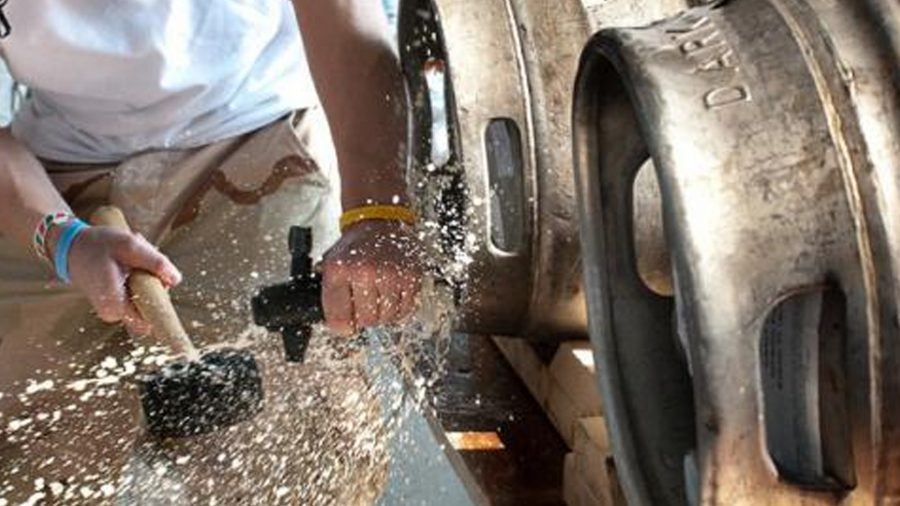What Is A Firkin? – Learn About Cask Beer Vs Infused Beer

On the surface, craft beer can seem fairly straight forward. But once you peel back that top layer, you’ll find a world full of confusing terms and acronyms. Defining those terms can help us all better experience craft beer. Which led me to the question “what is a Firkin?”
Firkin sounds like something you’d yell when hurt or mad. But no, it is not a cuss word.
Quite the opposite, in the craft beer world, the word Firkin is quite appealing to those that know and understand what it means.
What Is A Firkin?
Technically, a Firkin is a specific size of a cask. It is 1/4 barrel or 10.8 gallons. There are other sizes as well Pin (5.4 gallons) and Kilderkin (21.6 gallons). 
Casks were originally made of wood but are now most commonly made of metal – they look just like mini kegs.
Casks were originally used to produce Cask Conditioned beer; also known as Real Ale.
Now many breweries use Firkins and other size casks to infuse beer with unique flavors.
For many, the word Firkin has simply replaced the term cask.
Understanding Cask Conditioned Beer
The beer you normally drink is filtered and carbonated with CO2 prior to being kegged. Then it is pushed out of the keg with CO2. Occassionally, nitrogen is used as well.
The carbon dioxide is what gives beer it’s “fizzy” characteristic and moves it through the tap system in your local bar or taproom.
Cask Conditioned beer is quite different. It is commonly not filtered and not carbonated. Instead, it is placed into the cask while the yeast is still alive so the beer is able to continue to ferment.
Fermentation produces CO2 gas which provides some carbonation. But not nearly as much as what is added to modern beer.
Since the beer isn’t filtered, the result is a beer that is often cloudy.
Technically, a Cask Conditioned beer should be served using a beer engine aka hand pump (think of the old water well pumps). This is a system that pulls the beer out of the cask. These are quite rare but some traditional pubs will offer this method of serving.

The other option is a cask tap which is more or less a faucet that’s driven into the side of the Firkin. Depending on the pressure inside of the Firkin and how accurate the cask tap is struck, it can create quite a mess.
Once tapped in this way, gravity takes over and allows the beer to flow through the faucet and out of the Firkin.
Ideally, beer of this style is served around 55 degrees but it will be highly dependent on the room temperature as it is not kept in the cooler. In the past, the casks were often stored in the basement were it could be kept at that temperature.
Why Are They Used?
Years ago, this is how beer was served because it was really the only way to serve beer. Sophisticated tap systems didn’t exist. Today, they are used for a number of reasons.
One reason is to provide a unique drinking experience. The lack of filtration and lower carbonation have a significant impact on the final product.
People often report a softer mouthfeel and gentle carbonation from a Cask Conditioned beer. Some may feel that the beer is flat but merely has different qualities.
Being at a higher serving temperature can aid in providing more aroma and flavor as well.
Another reason is to give the brewery opportunities to experiment with new flavors. This is done by adding something unique to the beer in the Firkin. However, when used this way, the brewery will often use finished beer.
These are not Cask Conditioned beers but rather beers infused with new flavors.
For this reason, they are often used during special events. Breweries are able to attract customers to their taproom by offering a Firkin of a popular beer that’s had a unique flavor added to it – often fruit, herbs, peppers, etc.
Misunderstanding And Potential Issues
Since Cask beers are not identical to standard beer, some customer may not know what to expect.
For that reason, articles like this one are really important – as is the bar’s staff’s ability to educate customers.
A customer can easily feel like there is an issue with the beer if the appearance or lack of carbonation isn’t what they expected.
The same can be said for the higher temperature. Many believe that all beer should be served cold and overcoming that belief isn’t easy.
In addition, beer kept in a cask should be drank quickly – normally within 48 hours of tapping. So if a brewery is unable to sell out within a few days, the beer could spoil.
It all comes down to education, it’s important that those drinking beer from a cask understand what they will be experiencing. And the brewery should explain the difference between a Cask Conditioned beer and an infused beer.
Final Thoughts
Be sure to stop by Cooper’s the last Friday of every month for our Firkin Friday Fundraiser and get tickets now for our Firkin Fest coming in March.
